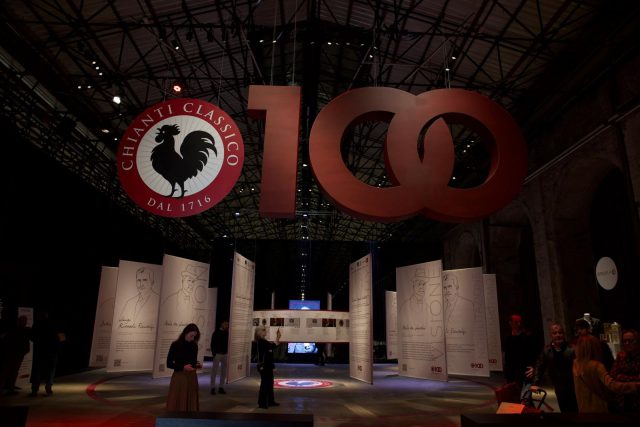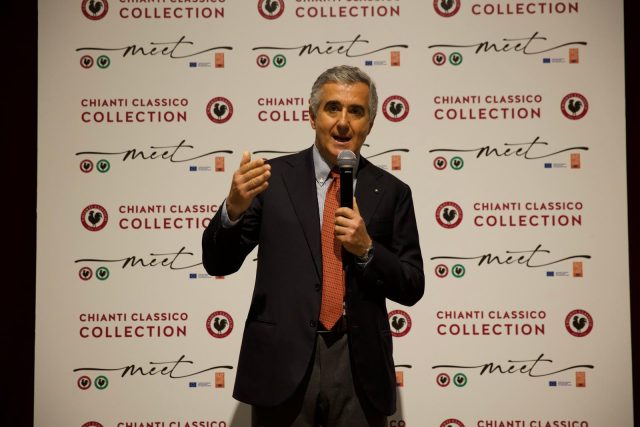This website uses cookies so that we can provide you with the best user experience possible. Cookie information is stored in your browser and performs functions such as recognising you when you return to our website and helping our team to understand which sections of the website you find most interesting and useful.
A century of Chianti Classico
Filippo Bartolotta celebrates the centenary of the Consorzio Vino Chianti Classico and delves into how recent vintages from the appellation have held up.

Almost 800 labels from more than 200 Chianti Classico producers in a stunning location in Florence to celebrate the 100th anniversary of the Consorzio – what more could you want? In 1924, 33 wine makers decided to create an association to promote and protect the wines of Chianti Classico and its production area which was actually already mentioned by the Grand Duke of Tuscany, Cosimo III de’ Medici in 1716 as one of the world first ever appellations.
After 100 years, the number of wine makers is around 350 spread out over 70,000 hectares of immaculate countryside between Florence and Siena, the sort of countryside that would have been familiar to Leonardo da Vinci.
Chianti Classico may have a winemaking pedigree stretching back 2,500 years, but the region is still in fine shape, according to consorzio president Giovanni Manetti: “Chianti Classico is in good heath. Last year we lost some of our crop, due to downy mildew, but the harvest was of good quality. Like most Italian appellations ,we saw a drop of 10% in sales in the export market but the stock depletion rate is encouraging as the pace is in line with previous years.”
“Prices have increased 7% from last year and are 13% above inflation– if we compare the data to that of 2021 – making Chianti Classico a profitable DOCG. We sell our wines in more than 160 countries, although two-thirds of the production is sold to three: the US is still number one with a 35% share; Italy grew from 19% to 22% over the two years; and Canada is steady with a solid 10% (with sales of the Gran Selezione category increasing by 50% over the course of last year).”

Chianti Classico Gran Selezione is regarded as the top category and it has a few extra requirements when compared to Chianti Classico and Chianti Classico Riserva.
Gran Selezione
- It must age for at least 30 months in oak before going to market (Chianti Classico’s minimum ageing is 12 months, while the Riserva’s is 24).
- The minimum percentage of Sangiovese goes from 80% to 90%
- If other varieties get in the blend, they must be indigenous ones (e.g.: Canaiolo, Colorino, etc.) only.
- All grapes must come only from the producers’ estates.
- Producers can also name the vineyard where the grapes are from if it’s a single vineyards.
- Producers can also mention one of the 11 UGAs (Additional Geographical Units). These define smaller and more precise areas within Chianti Classico: San Casciano, Panzano, Greve, Montefiorale, Lamole, San Donato in Poggio, Castellina, Radda, Gialle, Vagliagli, and Castelnuovo Berardenga.
Athough probably not entirely accurate ,we could say that Gran Selezione is a sort of Grand Cru system which requires stricter rules around the winemaking and which indicates where the wine is from with greater precision.
“We are now producing two million bottles of Gran Selezione each year, and this is increasing the reputation of this appellation as these labels end up in fine dining and collectors’ cellars,” Manetti explained. “Also ,it’s been proving extremely beneficial for our community as it has helped us to focus more than ever on sense of place and identity. We love that our Chianti Classico can not only be more terroir-driven wines, but also more soul-driven ones!”
The 2024 en primeur tasting of Chianti Classico this year showcased the 2022, 2021, 2020 and 2019 vintages.
I am a huge fan of the young vintages of Chianti Classico, which this year display the super hot 2022 vintage. Expectations were low and above all I was prepared for some overripe and pretty alcoholic samples. The reality was starkly different. Most of the wines I have tasted are pretty crispy and fresh with a delightful integrity off red fruit, violets and even some forest floor complexity. Good examples of these highly value for money reds are: Castellinuzza e Piuca, Istine, Castellare, Cigliano, Montecalvi, Rocca delle Macie, Riecine; Tenuta di Carleone and Terra di Seta. The overall quality was pretty homogenous across the board, and it was impossible not to spot the elegant Chianti Classico identity.
Among the Riserva and Gran Selezione wines I found a broader diversity of styles and quality given the different vintages available on the market, which ranged from 2020 all the way to 2016.
I focused mainly on the 2021 Riservas showing power and elegance, like: Antinori, Villa Antinori, Cigliano di Sopra, Vigneto Branca, Dievole, Novecento, San Giusto a Rentennano, Le Baroncole; Monteraponi, Il Campitello.
Also some sweet and juicy fruit driven 2020 Riservas, like: Badia a Coltibuono, Castello di Ama Montebuoni, Cinciano, Val delle Corti, Villa Cerna & Rosa, and Bordone.
Among the Gran Selezione 2020s I saw some more structure and ageing potential, especially in the following: Casa Emma; Castello di Brolio, Colledìla; Conti Capponi, Contessa Luisa; Castello di Albola Solatio; Castello di Fonterutoli Vicoreggio 36; I Fabbri; Felsina, Colonia; Principe Corsini, Zac; Terreno Asofia; Querciabella.
In general terms though, should you choose to go for these more ambitious wines, there will always be more depth, concentration, structure and complexity of aromas when hitting the right labels, but also some more muscular, alcoholic and woodier wines. One last important piece of feedback that I bring with me at the and of these two busy days of tastings and celebrations is how my palate is feeling: my mouth feels pretty clean, tannins and oak didn’t kill my gums. For me, this is a telltale sign of a mature and self aware appellation which is showing clearer and clearer intention to speak with a more terroir-driven dialect.
Related reading:
The art of Vino Nobile di Montepulciano: 40 years of Tenuta Vallocaia
Everything you need to know about Brunello di Montalcino’s 2019s
Related news
Glenfiddich becomes official partner of Aston Martin F1 team
Spain 'needs to learn how to market our fine wines', producer claims
Bourgogne wine see global growth despite difficult market conditions

